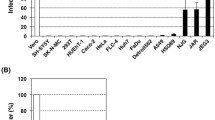Summary
Persistently infected cell lines of BHK21/WI-2 cells have been established by infection with the wild type rubella virus strain M-33. These cell lines, BHK-MP1 and BHK-MP2, showed immunity-like resistance to superinfection with M-33 virus at both 34° and 39.5° C. They also showed intrinsic interference with the replication of Newcastle Disease Virus at 34° C but not at 39.5° C. They released a small number of infectious virus particles which were temperature sensitive variants, being able to form plaques at 34° C, but not at 39.5° C on BHK21/WI-2 and on its derivative, BSR.
When BHK-MP1 cells were cultured at 34° C in growth medium containing 10–20 µg/ml of 5-bromodeoxyuridine (BudR) there was a 5- to 10-fold increase in infectious virus in the medium as compared with the untreated controls. Mitomycin C (0.5 µg/ml) treatment for 7 hours likewise stimulated the release of virus from these cells. The enhancement of viral release by BudR was completely blocked by pretreatment with actinomycin D (5 µg/ml) for 3 hours prior to BudR treatment. Since the variant can be induced by these prophage inducers and inhibited by actinomycin D it is suggested that the viral genome is converted to a DNA provirus which is analogous to the lysogenic state of bacteriophage.
Similar content being viewed by others
References
Cohen, S. M., Ducharme, C. P., Carpenter, C. A., Deibel, R.: Rubella antibody in IgG and IgM immunoglobulins detected by immunofluorescence. J. Lab. clin. Med.72, 760–766 (1968).
Dulbecco, R., Vogt, M.: Plaque formation and isolation of pure lines with poliomyelitis virus. J. exp. Med.99, 167–182 (1954).
Marcus, P. I., Carver, D. H.: Hemadsorption-negative plaque test: New assay for rubella virus revealing unique interference. Science149, 983–986 (1965).
Mifune, K., Matsuo, S.: Some properties of temperature-sensitive mutant of rubella virus defective in the induction of interference to Newcastle disease virus. Virology63, 278–281 (1975).
Parkman, P. D., Beuscher, E. L., Artenstein, M. S.: Recovery of rubella virus from army recruits. Proc. Soc. Biol. Med.111, 225–230 (1962).
Sato, M., Yamada, T., Yamamoto, K., Yamamoto, N.: Evidence for hybrid formation between rubella virus and a latent virus of BHK21/WI-2 cells. Virology69, 691–699 (1976).
Sato, M., Maeda, M., Yoshida, H., Urade, M., Saito, S., Miyazaki, T., Shibata, T., Watanabe, M.: Plaque formation of herpes virus hominis type 2 and rubella virus in variants isolated from the colonies of BHK21/WI-2 cells formed in soft agar. Arch. Virol.53, 269–273 (1977).
Simpson, R. W., Iinuma, M.: Recovery of infectious proviral DNA from mammalian cells infected with respiratory syncytial virus. Pro. Nat. Acad. Sci. U.S.A.72, 3230–3234 (1975).
Zhdanov, V. M.: Integration of viral genomes. Nature256, 471–473 (1975).
Author information
Authors and Affiliations
Additional information
With 2 Figures
Rights and permissions
About this article
Cite this article
Sato, M., Tanaka, H., Yamada, T. et al. Persistent infection of BHK21/WI-2 cells with rubella virus and characterization of rubella variants. Archives of Virology 54, 333–343 (1977). https://doi.org/10.1007/BF01314778
Received:
Accepted:
Issue Date:
DOI: https://doi.org/10.1007/BF01314778




